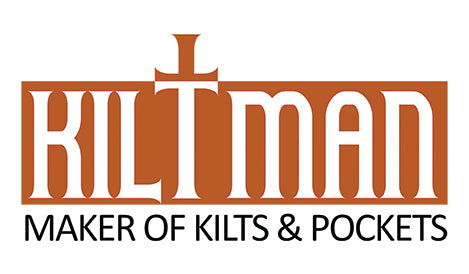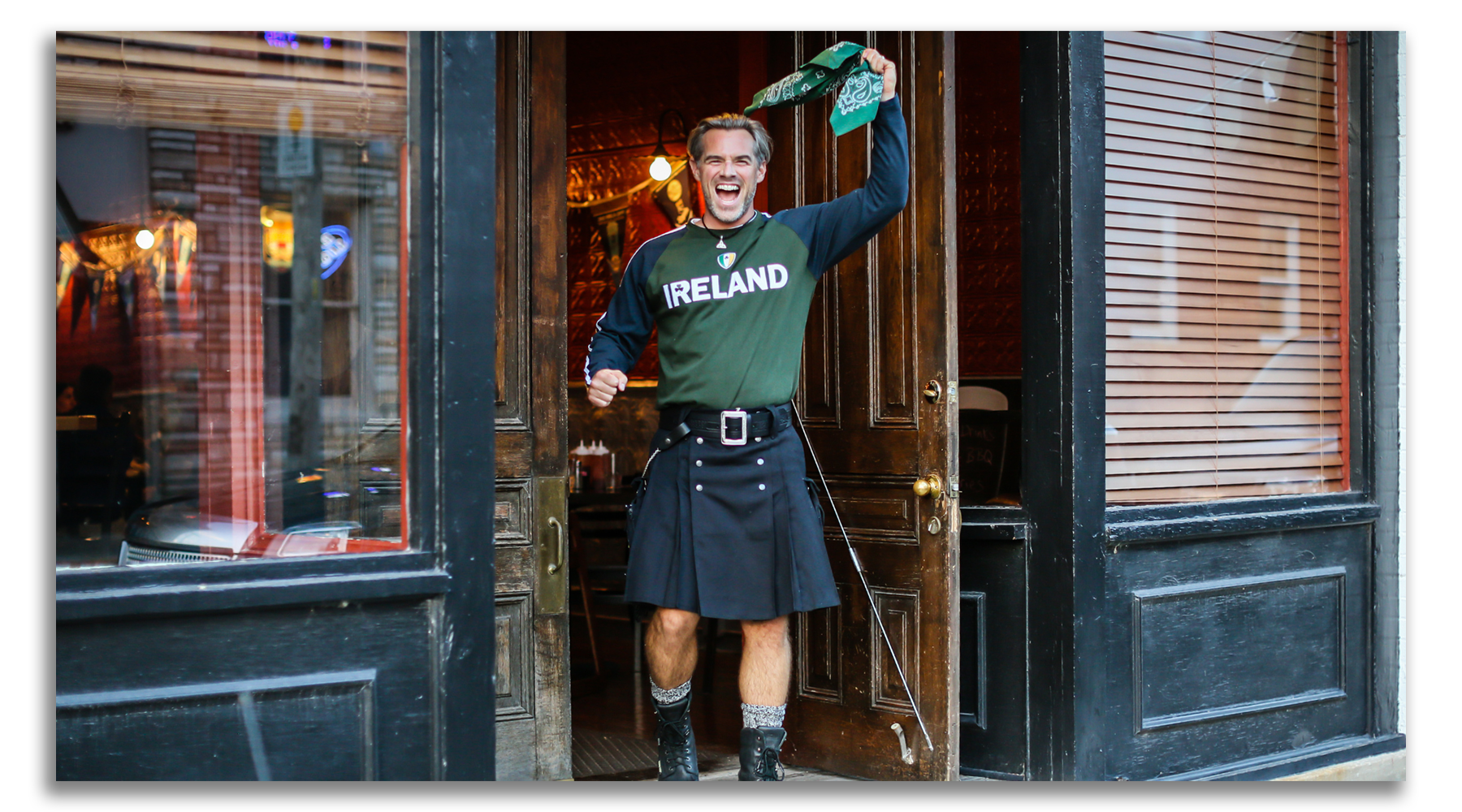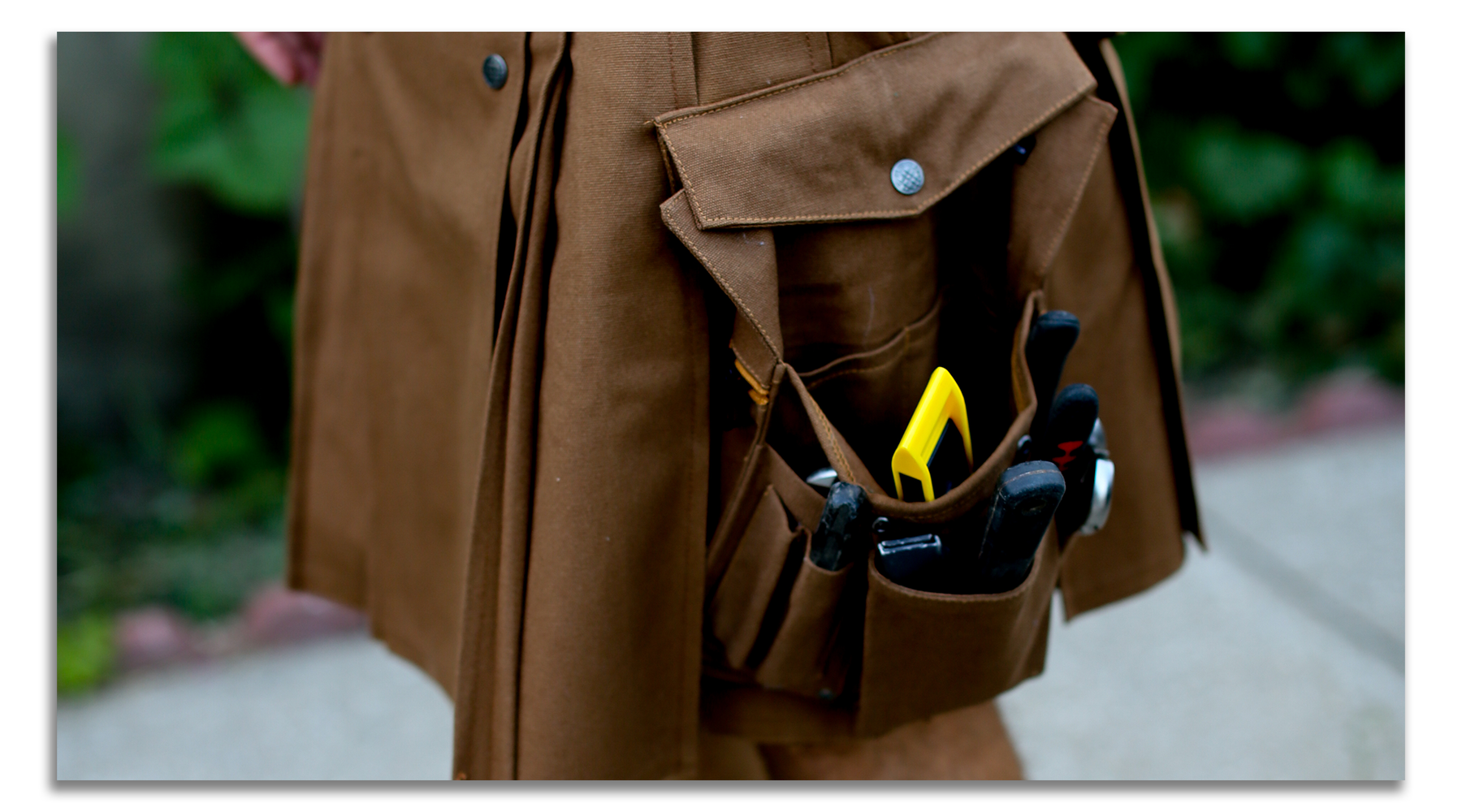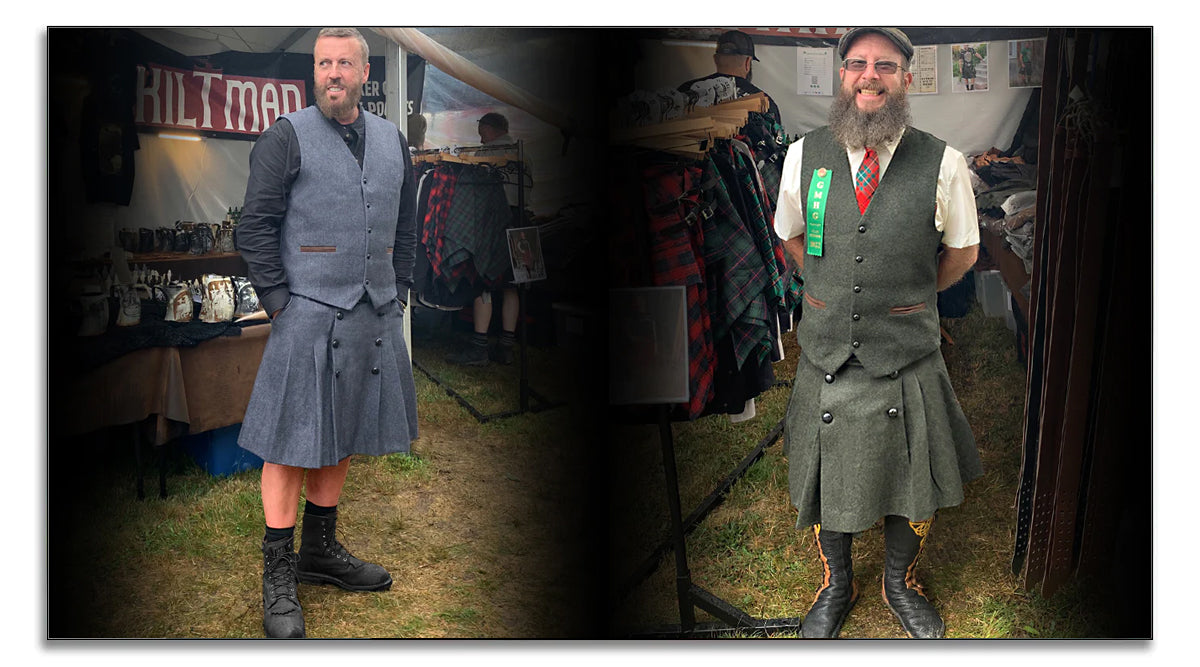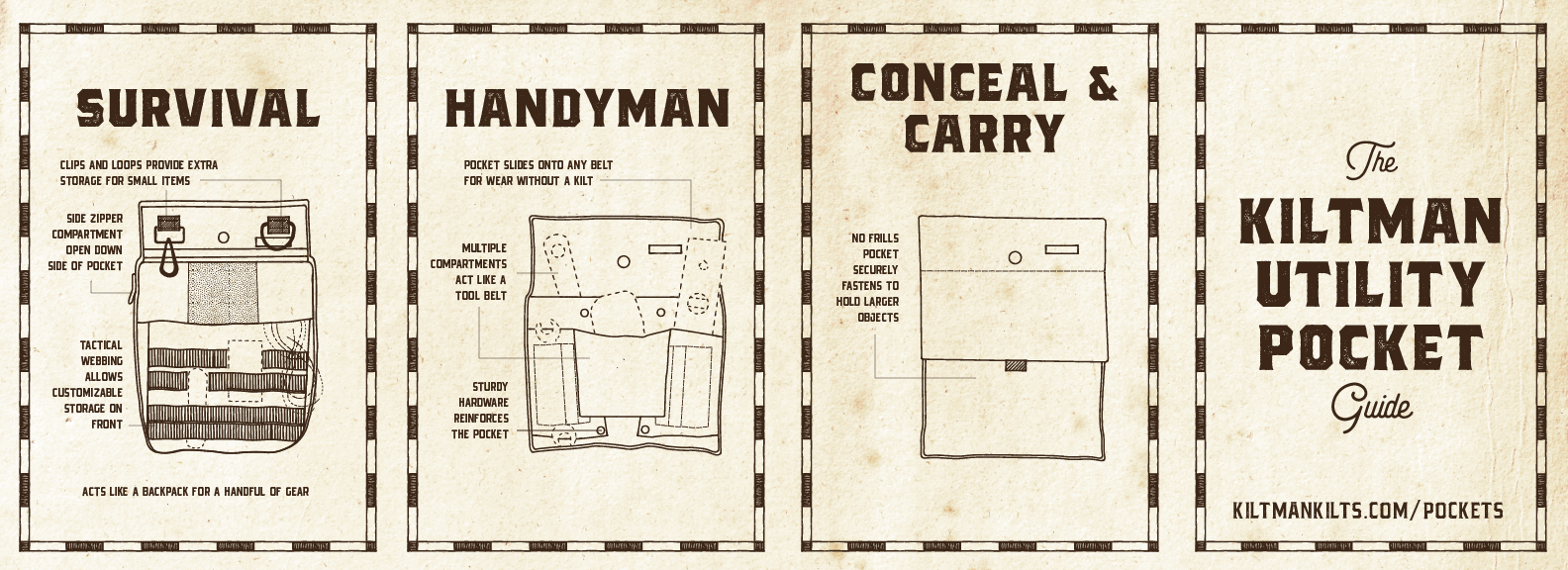You're probably here because your'e looking for a quality kilt. Well, look no further. Whatever occasion it may be, a Kiltman Kilt will get you through it. So what do you say? Check out our amazing collection of utility kilts.
Haven't you heard? We are the king of kilt pockets. You've got the kilt. Now it needs a buddy. Whether you're working on a project, running errands, or hanging out and relaxing - there's a pocket for that. Our Kiltman pocket collection can do it all.
Ready to step up your kilt game? With real leather, high-quality kilt belts and unique, out-of-this-world pins and accessories - don't hesitate to take your style to the next level. It's different. But that's what makes a Kiltman a Kiltman.
Looking for a high-end kilt with a matching vest? Look no further. Our wool blended, tweed collection with matching leather buttons is perfect for weddings, special occasions or simply wanting to look like the sharpest guy in the pub.
What Makes a Kiltman Kilt
Value, Customer Service, Pockets, The Look, The Fit and The Fabric. It doesn't just take one aspect of a Kilt to make it a Kiltman Kilt. Just like the Kiltman is more than just a Kiltmaker! Kiltman prides himself in these important values to bring you the best Utility Kilt on the market!
Don’t box us in. We're Kiltman! You already know Kiltman brings you the best in contemporary kilts. But Kiltman also makes something that no one else does: heavy duty, freely detachable, purposed pockets.
History of Kilts
Kilts may be one of the world's most recognizable forms of ethnic apparel, but where did they come from, and how have they changed over the years? This article will concisely tell the story of the kilt from its origins to modern times.
The Climate, Cloth, and Culture that Conceived the Kilt
Scotland has a bracing climate, prone to rain and cold Atlantic winds. So, while the Scotts made quality linen from flax, wool was always prized for its versatility and exceptional insulation (even when wet). So, by focusing on shepherding flocks, traditional cultures could simultaneously provide wool for clothing, bedding, sails, and so forth, all while also having a source of meat, milk, and cheese.
Whether shepherding, herding cattle, patrolling their lands, raiding their rivals, or going to war, the men of this region were often on the move. They had to travel light, so they needed a garment that could be used in various ways to face changing conditions. The original kilts included additional material that was worn over the shoulder (described in more detail below) and replaced pants, jackets, cloaks, and sleeping bags. Kilts had no seat, knees, or crotch to wear out, so a good kilt could see years of hard service. Because they were adjustable, kilts grew with a person and could be as useful against the winter winds as the summer rains.
All in all, this one garment took the place of many different articles of clothing and equipment. Its climate-adapting properties and durability would not be matched until modern times. Because of the kilt, Highlanders could travel swiftly and unencumbered over any terrain. This added greatly to their martial prowess and military reputation.
Before Kilts
Kilts are first mentioned in the 1500s. It is possible kilts were in existence before that, but there is not enough evidence to say. Remember, most fabrics do not last long buried in the ground and so often elude archeological scrutiny. Before kilts, many forms of garments were worn in Scotland, Ireland, Wales, and elsewhere. One of the most common was a loose fitting tunic. Men wearing such a garment usually went bare-legged.
Vikings were very active in Scotland and Ireland from about 795 until their gradual assimilation into both countries. According to one Viking age eyewitness (Ibn Fadlan), Vikings had a garment that they wore over one shoulder to keep their weapon hand free. Another eyewitness, Ibn Rusta, remarked on the over abundance of cloth Vikings folded together into pleated pants. These pleats and one-shouldered cloak sound very similar to the later Scottish kilt. What is also interesting is that the word ‘kilt’ comes from an Old Norse word ‘kjilt,' which means 'pleated.’
The Belted Plaid, or Great Kilt
The first true kilts were the “belted plaid” (breacan) or great kilt (filleadh mòr). These were long swaths of wool cloth arranged in pleats (folded, not sewn), gathered with a sturdy leather belt, and then the remainder tossed over the shoulder as a cloak. It has been suggested that this would be difficult to do without help, and so the Scotsman was aided by the lady in his life or would have to lie the kilt on the ground and then quickly but carefully wrap himself up in it. The belted plaid made for an impressive silhouette and added to the Highlander’s personal presentation (always highly valued in Northern European warrior societies).
One of the most famous characteristics of this garment was the plaid itself. Plaid is produced by precise weaving of differently dyed wool thread into a careful pattern. Each clan in Scotland had its pattern or tartan. So, the great kilt not only provided the wearer with the versatile clothing he needed but also boasted his connections and identity. Though the kilt would change in time, this feature of the family tartan would persist as a cultural treasure in Scottish kilts. Kilts in other lands (such as Ireland) would not superimpose this tradition and instead favor solid-colored kilts. So, to this day, even if someone of Scottish heritage does not own a kilt, they will still often have something displaying their family tartan.
Transitions
By the early 18th century, life was changing. Economic and political conditions forced people into new livelihoods, and urbanization increased. As people’s lives changed, their needs changed, and much of what once made the great kilt practical now made it impractical.
It is widely held (though not without controversy) that a Quaker industrialist, Thomas Rawlinson, changed the kilt around 1720. Rawlinson thought a slightly shorter kilt without the cloak portion with the pleats already sewn in place would be much more practical garments for the miners, loggers, smiths, workers, and soldiers now wearing the kilt. This new kilt was called the “little kilt” or filleadh beag (usually rendered ‘philibeg’). Ian MacDonnell, chief of the Inverness MacDonnells, adopted and improved the design, and with his endorsement, the philibeg kilt caught on.
A contrary assessment is that the philibeg began to evolve as early as the 1690s, and all Rawlinson and MacDonnell innovated were the pre-sewn pleats.
The defeat of the Scottish Highlanders by the highly regulated and disciplined British Army at the Battle of Culloden in 1746 marked a decisive end to the old way of life. After the Battle of Culloden, the British Parliament sought to assimilate the troublesome Scotts forcibly. The Act of Proscription (1746), including the Dress Act, outlawed the kilt and other identifiers of Scottish heritage.
The British would (again) see that culture is not so easily suppressed, and even before the Act of Proscription was repealed in 1782, a revival of Scottish culture was brewing. However, as Highlander Societies, Scottish games, and Scottish military regiments restored (or rather, brought back into the light) their old culture, it was the “little kilt” and not the “great kilt” that survived.
Kilts in Action
The 18th and 19th centuries saw the British Empire reach the heights of its power. However, Scottish and Irish regiments performed much of the fighting required to accomplish this. Many Scottish companies wore kilts into battle up through World War I, and many still wear kilts as part of their dress uniform to the present day. Irish regiments would adopt the solid-colored saffron kilt. As tales of the battlefield prowess of these fighting men drew attention, the kilt became strongly associated with bravery and prowess.
Because many of the first municipal police and fire departments in the United States and Canada were recruited from Irish and Scottish immigrants, city public safety departments often feature kilts in their parade dress. Of course, many of these soldiers, cops, and firefighters are accompanied by kilt-wearing pipe and drum corps, proudly playing the bagpipes (originally invented as "war pipes").
As Scottish and Celtic festivals, Highland games (and Scottish and Irish dancing) have grown in popularity, the kilt has become a symbol of pride and competition. The kilt has even bled over into other sports, such as lacrosse and rugby.
Kilts Today
Kilts have become famous the world over. Besides Celtic festivals and Highland Games, it is common to see people wearing kilts as part of formal dress at weddings, funerals, parties, or just visiting a local pub or brewery. There are many modes of this formal dress (centered around the kilt) that are far too complex and too nuanced to go into here. However, kilts are not (and never were) just for auspicious events. Since the 1980s, kilts have been reimagined and relaunched for everyday wear.
Contemporary, utility kilts bring many features and advantages over traditional kilts, such as more durable material, pockets (both built-in and detachable) and solid colors that are more modern, yet still communicates your Celtic heritage.
So, kilts have been around for hundreds of years. They have gone from the garments of rugged men in the wild to soldiers' uniforms to today's symbol of heritage and pride. Today, kilts continue to evolve and still find relevance in any situation.
Kiltman News

The History of the Kilt: From Scottish Highlands to Modern Celtic Heritage
by Kurt Evald Noer September 17, 2024
Important Links
News & Updates
Sign up to get the latest on sales, new releases and more…
Contact Us
Phone: 833-KILTMAN (833-545-8626)
Email: kilts@kiltmankilts.com
© 2025 Kiltman Kilts. Powered by Shopify
